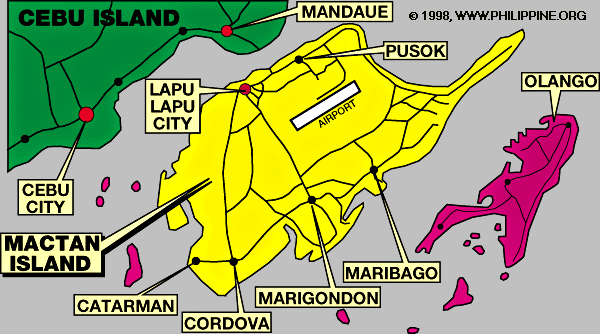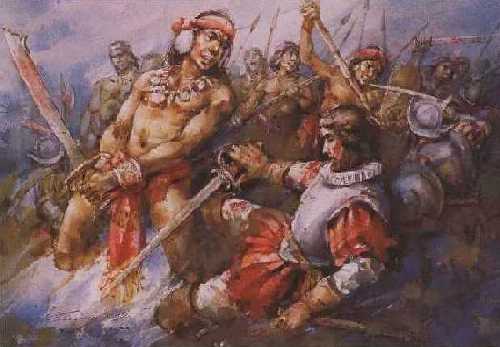LAPULAPU MONUMENT, Punta Engaño, Lapulapu City- Site where the battle between Mactan Island Chieftain Lapulapu and the Foreign aggressor Ferdinand Magellan occurred in April 27, 1521. It depicts the hero holding a bolo in one hand and a pestle on the other. Said weapons were believed to have been used during his combat with Magellan. This monument stands as a reminder of Filipino bravery. |
On 27.April 1521, the spanish conquering explorer Ferdinand Magellan lost his life in a battle while attempting to make a landing in Punta Engano. Punta Engano is the north-eastern corner of Mactan Island. In 1866 a memorial , the Magellan Marker, was erected to commemorate the spot where he fell. A few metres away, a statue of Chief Lapu-Lapu, complete with sword and shield, keeps the memory of this popular hero alive. The historic battle for Mactan (Kadaugan sa Mactan) is re-enacted each year on the beach at Magellan Bay by amateur actors, providing a sponsor can be found. The Tourist Office should be able to provide you with up-to-date information. |
LAPULAPU Chief Lapulapu”s (1491-1542) other name is Kolipulako. The hero of Mactan and conqueror of Magellan, is described as stern, proud, intelligent, unyielding. He waged continuous war against the powerful ruler of Cebu, then a very much greater kingdom than his little island of Maktang. Of him, President Gullas of the University of the Visayas writes: “Lapulapu is a good example of determination and willingness to work well. He learned how to ride on a horseback and on carabao proficiently at the age of six years; knew how to read and write at seven; boxed well at nine; became a champion swimmer, boxer and wrestler at eighteen; beat the Bornean marauders and pirates twice at twenty.” In the lives of men who have almost become legendary one finds it diffucult to separate fact from fiction. This must be true in the case of the material quoted above. History has it that Mactan Island although small was a thriving community when the great Magellan was in Cebu. The brave Spanish navigator and soldier, upon learning that some inhabitants on this tiny island across Cebu refused to recognize the King of Spain, burned one of the villages. Lapulapu was one of he native leaders who refused to acknowledge the sovereignty of Spain over the Islands. When Magellan, “with three boatloads of Spaniards and twenty boatloads of Cebuanos” went to Mactan to help a friendly chief, Lapulapu and his men armed with native fighting elements - wooden shields, bows and arrows, lances - met them. The invading Spaniards and Cebuanos were driven back to their boats, but their brace leader, Magellan, net death in the hands of Lapulapu. On what is believed to be the exact spot where Magellan fell and died, now stands an imposing monument in honor of the gallant explorer. In the well-kept plaza of Opon, one of the two towns on Mactan Island, stands today an inspiring monument in honor of Lapulapu, considered the first Filipino to have repelled European aggression.
MAGELLAN MARKER, Punta Engaño Lapulapu City about 20 kms. From Cebu City. Encouraged by the success of Christianizing the people of Cebu, Magellan crossed the channel to Mactan Island in an effort to spread the faith. Before he reached the shores, he was killed by the chieftain of the island, Lapulapu and his men during the battle for supremacy and freedom on April 27, 1521. Efforts to retrieve the body of Magellan were futile inspite of the offer to trade jewelries and spices for the dead body. This marker was erected in 1866 to mark the spot where the great explorer died. One of the oldest monuments in the province, the Magellan monument in Barangay Mactan (Lapu-Lapu City) traces its origin to December 4, 1840, when Spanish Governor-General Francisco Alcala approved the plan to construct a monument in Punta Engaño, Mactan, in honor of Ferdinand Magellan, the Portuguese “discoverer” of the Philippines. |
The actual circumstances of its construction, however, are not quite clear. It appears that as of 1858, a Magellan monument had already been erected but this may not be the same monument that exists today. Karl von Scherzer, who visited the Philippines in 1858 as a member of an Austrian naval expedition, wrote that on Mactan island “there was also erected on the promontory of Sugaño (Punta Engaño) a monument to the memory of Magelhaens (Magellan), and the happy idea was entertained of making it also a lighthouse to warn ships of the danger in approaching the immense number of reefs that are found here. “Though it is not clear whether Scherzer himself saw the monument, it can be assumed that the original monument was a monument-cum-lighthouse in a promontory of Punta Engaño. The monument that now exists in Barangay Mactan - a classic obelisk on a multi-level base - is said to have been built in 1866 during the administration of the Augustinian priest Simon Aguirre, who was cura of Opon (now Lapu-Lapu) in 1857-71. It is an important landmark that, even today, has not been given the full care and respect it deserves. Source from Sun*Star Weekend |
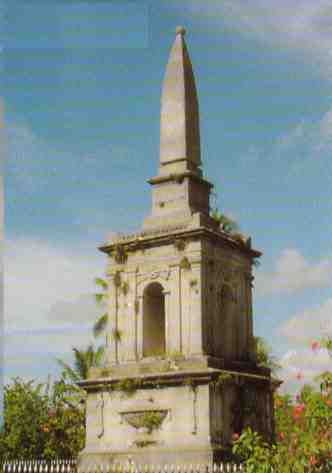
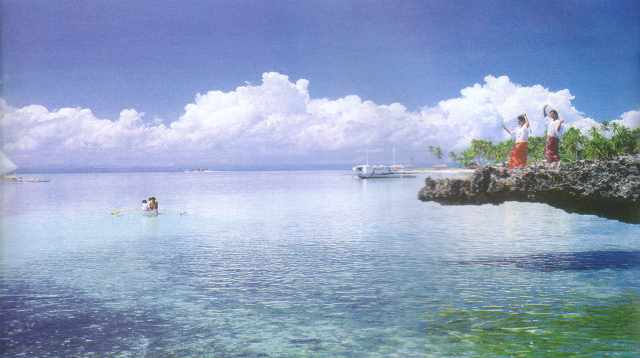
Mactan, Rocky Island
Mactan Island is also known for his famous guitar factories.
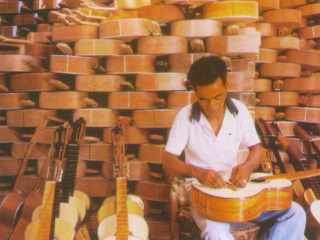
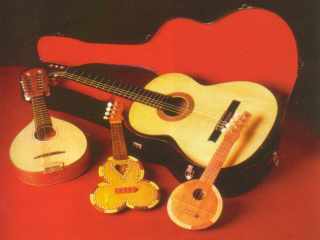
Mactan Island is known for his beautiful beaches and diving sites. They call it the diving mecca of the south. Mactan has more than a dozen beach resorts with complete diving facilities. Divesites along the edge of the island are very convenient for beginners and advances divers alike. There is a slight current and a perpendicular drop-off which goes down 30 to 50 meters. |
Links about Mactan :
|
Malapascua Island

Visayan Sea, Cebu, Philippines,
